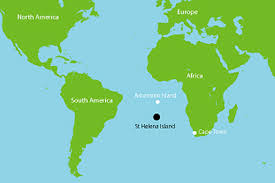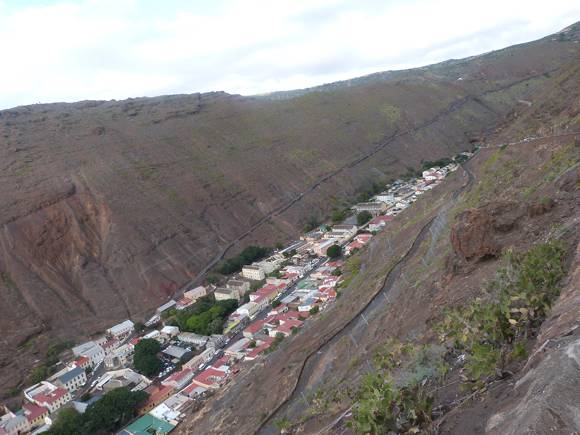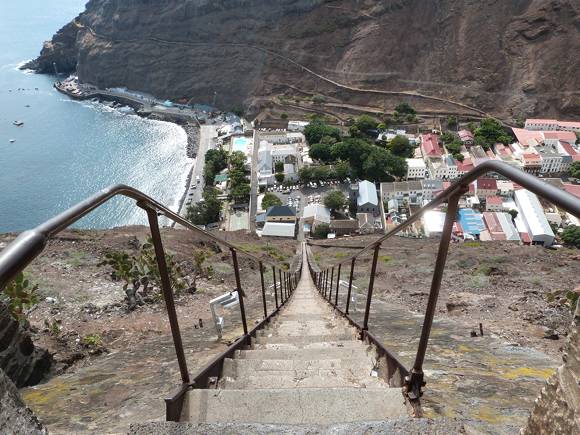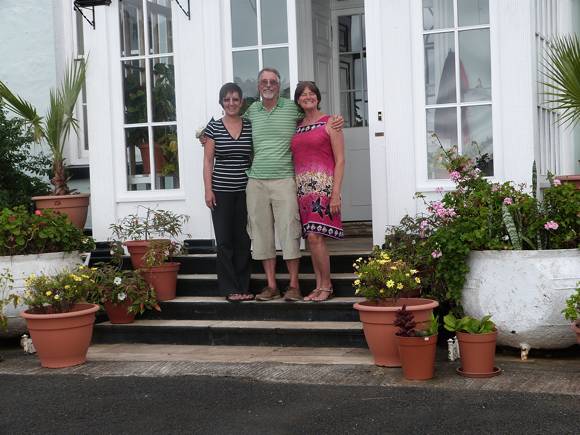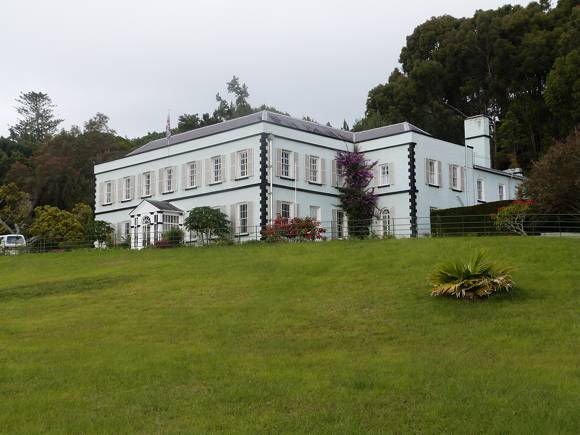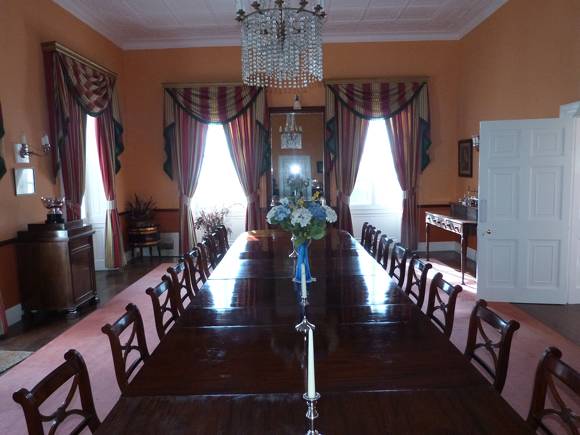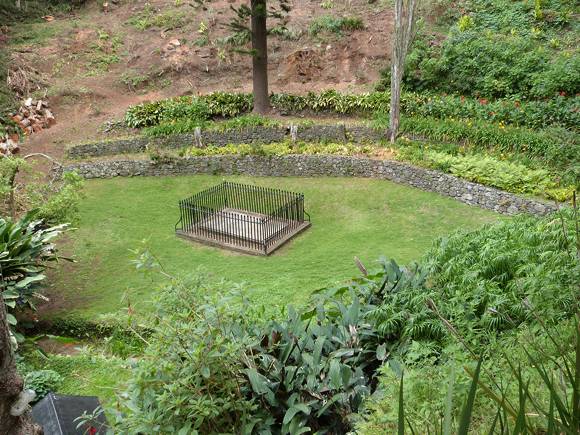St. Helena

15:95.0S, 005:71.67W
We love hearing from you but please do not hit the reply button. It sends all the pictures back to us. Send us a separate email. Thanks
-----------------------------------------------------------
Where in the World are Margie and Peter? St. Helena!
As most of our readers know, Peter and I had originally planned to sail a northwest course across the Indian Ocean through the Gulf of Aden and into the Red Sea where we would pass through the Suez Canal and into the Mediterranean.
All that changed in 2011, when the American sailing yacht, Quest, was taken by Somali pirates and the four Americans onboard, including two good friends of ours, were killed. Like most other cruisers, we made the decision to take a more southerly route across the Indian Ocean where we would round the Cape of Good Hope in South Africa and then proceed to Namibia before beginning our passage across the Atlantic to the Caribbean.
Our disappointment at the change in our itinerary was very short-lived! We feel so blessed to have been lucky enough to visit the islands of Rodrigues, Mauritius and Reunion along our detour. And, once we arrived in South Africa, calling on Richard’s Bay, Durban, Knysna and Cape Town, as well as a short visit to Swaziland, we were captivated by the astounding beauty and cultural melting pot that is this part of Africa – not to mention the warm hospitality of South Africans, Swazilanders and Namibians. As they say, one door closes but another one opens…
But, it’s time to cross that last ocean and tie the knot on our circumnavigation so the journey continues…
Leaving Namibia proved to be a bit more difficult than we imagined due to a number of problems associated with our autopilot. We left Walvis Bay, Namibia headed for St. Helena but, after only 36 hours, we were forced to return when a bolt sheared off and disengaged the hydraulic ram that controls the steering mechanism. We found a mechanic who welded the piece back together and we were off again four days later However, five days into our nine day passage, after fighting heavy seas and high winds of up to 40 knots, the weld broke again! This time, we were too far away from Namibia to turn back so we set up our emergency autopilot - which is not built to handle extreme sea conditions – and we prayed very hard to Poseidon to send us good weather. Luckily, the next four days, proved to be ideal light wind sailing and we thankfully arrived in St. Helena on May 25th all in one piece.
Discovered in 1502 by the Portuguese sailor, Joao da Nova, St. Helena (pronounced Hell..LEE.. na) was largely ignored by the Portuguese (as well as the other European colonial powers) until the early 1600’s when the island’s ideal position as a watering/provisioning stopover became apparent. The first British settlers arrived in 1659 but, for a time, control of the island bounced back and forth between the British and the Dutch. However, by 1673, the Brits recaptured the island for the last time and St. Helena became one of the British Overseas Territories. This tiny island out in the middle of the Atlantic Ocean, nearly 4000 miles from the UK, proudly exhibits fealty to its British heritage as defined by their motto, “Loyal and Unshakable.”
A small community called Jamestown began to grow on the NW coast of the island. Today, Jamestown is the capital of St. Helena and is home to around 4,500 people, known as “Saints.” Sandwiched between steep volcanic cliffs, the town is rather long, thin and densely populated, with tightly knit, long winding streets and some interesting historic buildings. The surrounding terrain is rough and steep.
One of the highlights of a visit to Jamestown (so I’m told) is to climb up the Inclined Plane, or what’s commonly known as Jacob’s Ladder. There are 699 steps to the top, covering a distance of 924 feet and reaching an elevation of 602 feet above sea level. My knees couldn’t take all that punishment…
The Ladder was originally built in 1829 as a tramway to haul manure generated by the livestock in Jamestown up to the top of Ladder Hill where it was used to improve the soil on the rocky west side of the island. Military supplies were also carried up to High Knoll Fort which protected the entrance to the harbor from above. On either side of the stairs was an inclined plane. Trams were hoisted up by donkey power and people who weren’t energetic enough to climb the Ladder were pulled up in boxcars. Today, it is primarily a tourist attraction and the Museum at the bottom of the stairway issues Certificates of Achievement to those who complete the round-trip.
Here’ Peter at the end of his journey up Jacob’s Ladder. He decided against the return trip and hitchhiked his way back to town via the long, paved highway.
I mentioned the harbor entrance which really needs to be seen to be believed. From the anchorage, you are offered the option of bringing your dinghy to the wharf or calling the launch service and paying one pound each way for pick-up and delivery to/from your boat. Having been warned by our yachtie friends ahead of us, there was never a question in our minds as to what we were going to do…
On a GOOD day, the transfer from the little launch boat to the dock was a white knuckle nightmare! Here are some photos of the approach to the dock that the driver had to negotiate dozens of times every day. You’ll see the surge as it collides with the dock and you’ll also see Margie preparing to fling herself, Tarzan-style, from the dock to the launch as it approaches for pick-up. You only have one go of this as the launch cannot stop. It just makes a swing-by as it is buffeted by the crashing waves.
And, people ask us, “Isn’t life on a boat kinda boring???” BITE YOUR TONGUE!!!
But, back to our history lessons…
England was content to have the East India Trading Company rule the island for two hundred years -considering that hundreds of their ships would stop in St. Helena for water and provisions on their way to the Far East.
A governor was appointed by the Company in charge of administrating the Territory. In 1834, that all changed when England took over the responsibilities of overseeing the government on St. Helena with a royally appointed governor who would serve as the King (or Queen’s) representative on the island.
The current governor, Mark Capes and his lovely wife, Tamara, live in a beautiful residence called Plantation House and Peter and I were lucky enough to become acquainted with them through the magic of the internet. Turns out, Governor Capes formerly served as Executive Administrator for the British Government in the Turks and Caicos Islands. Our dear friends, Gillian and Ian Miller, know them well and introduced us online. Unfortunately, the Governor and his wife were not in St. Helena the week we arrived on the island but they graciously made arrangements for us to receive a guided tour of Plantation House with Debbie, the Resident Manager.
The original residence was built in 1673. The current house was built in 1792 and has had numerous renovations. It is Georgian in style and very grand with spectacular views down to the sea. The wide lawn in front of the house serves as a paddock for five giant tortoises including Jonathan, believed to be the oldest living tortoise in the world at 176 years of age.
Inside Plantation House, we were treated to a real “behind the scenes” tour with Debbie who showed us not only the beautiful, exquisitely furnished, public rooms but also the staff quarters, kitchen and private living areas. Here are just a couple of the 35 rooms in this stately manor home.
Another highlight of our visit to St. Helena was a full day tour of the island with Robert Peters. This energetic, 78-year old native “Saint” offers a History on Wheels Tour of St. Helena that can’t be beat. We criss-crossed the island and learned so much about the culture, history, geography, geology and the flora and fauna. We were absolutely amazed by the wealth of knowledge and all the amusing anecdotes that Robert imparted to us with rapid fire memory.
Here are a photo of Robert on the tour. He’s showing us some flax which is used to make rope. (He should know! He actually worked on a flax mill from 1951-1955) It’s an exotic species that was introduced to St. Helena over a hundred years ago and has crowded out the endemic trees and shrubs all over the island. Conservationists are starting to clear areas of invasive species and replacing them with native plants.
In some other photos, you’ll see spectacular landscapes and bulcolic farms. We drove by Halley’s Mount, where Edmund Halley actually lived while studying the galaxies here and I can only tell you that the night sky here in the middle of the Atlantic Ocean is simply breath-taking!
And, last but not least, St. Helena’s most famous resident dead guy – Napoleon!
He’s actually no longer there but the French government still maintains the plot as well as Landmoor, the house where he was held in exile from 1816 to 1821.
The Brits were so worried that the French would try to rescue Napoleon that they increased the troops on the island at that time from 600 to 3,000, built several mountain forts at strategic locations, had two warships on permanent readiness, and two armed sloops sailing around the island in opposite directions, 24 hours a day! Needless to say, there was no rescue attempt and Napoleon’s final escape from St. Helena happened 19 years after he died when his body was exhumed and taken to France in a coffin.
Napoleon was apparently very unhappy on St. Helena despite the fact that he was treated with utmost respect; given freedom walk about the plantation and surrounded by several of his trusted generals and a full-time physician. If the “Saints” were as friendly then as they are now, he couldn’t have had much to complain about. We found the island to be a delightful step back in time. There’s no cell phones, no widespread internet, no ATM’s and not even an airport until sometime in 2015 when life will really change. But, right now, it’s truly a town where “everybody knows your name.” Cheers!!!
Your arm gets tired from waving, waving and waving at everyone who drives by. Or else, you’ll be smiling and saying “Hello” to those who pass you on the sidewalk. Most people have nicknames like “Cookie” and “Fishhead” and “Bugman” and after a few days, you’ll be calling out to friends like you’ve lived here all your life!
But, friendships are on the line when the supply boat, S/V St. Helena comes in once every two weeks (sometimes three) with goods and provisions from South Africa! Then, it’s a free-for-all to secure a dozen eggs, a slab of cheese, a few fresh fruits and vegetables and perhaps a chocolate bar from one of the three little food shops in town. There’s nothing like a modern supermarket on St. Helena and we were so desperate for eggs that we each stationed ourselves at a different shop and hung out by the store room so we could pounce on the egg cartons when they were brought out! I was reminded of the frenzy that surrounded the Cabbage Patch Kids dolls when our girls were young and how I almost came to “fisticuffs” with a woman in “Toys are Us” just before Christmas!
But, aside from the days when “The ship is in!” and the next two weeks dinner is at stake, St. Helena is a beautiful time warp with gentle people who always eager to stop and get to know you. It’s an island where we’ve felt very much at home from the minute we arrived. Peter was delighted to hear Country Music from the USA playing on the local radio station and I thought it was so charming that birthdays are still announced on the radio followed by the music of “Somewhere Over the Rainbow.”
Where else can you find Donkey Walking Tours as an attraction? The donkeys need exercise to keep them in shape to carry endemic plants up the mountains to help conservationists restore the natural eco-system to St. Helena!
Now, if this isn’t Heaven, it’s pretty darn close!
--
--
